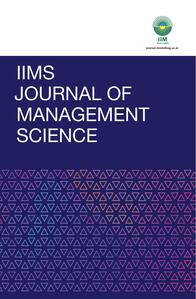
1 Centre of Excellence in Public Policy and Government, Indian Institute of Management Kashipur, Uttarakhand, India
2 School of Media Studies, Presidency University, Bangalore, Karnataka, India
3 Department of Social Work, University of Delhi, New Delhi, India
4 Institute of Mass Communication, Film and Television Studies, Kolkata, West Bengal, India
Creative Commons Non Commercial CC BY-NC: This article is distributed under the terms of the Creative Commons Attribution-NonCommercial 4.0 License (http://www.creativecommons.org/licenses/by-nc/4.0/) which permits non-Commercial use, reproduction and distribution of the work without further permission provided the original work is attributed.
The imminent climate disaster demands prompt consideration and implementation of measures in susceptible areas like Kullu, Himachal Pradesh. Utilizing secondary data, this study conducts a rigorous examination of the climate risk assessment, management, and governance dynamics within the region. It aims to elucidate the complex interaction between historical climate patterns, existing vulnerabilities, and potential approaches for mitigating risks and enhancing governance. This study examines the evolving climate patterns in Kullu’s region, highlighting the urgent requirement for effective water management practices and resilient agricultural strategies. The research provides advance notice of the forthcoming hydrological risks, emphasizing the need for a combination of scientific advancements and community involvement in developing effective governance approaches. Additionally, the researcher emphasizes the significance of improving early warning systems, promoting community-centered initiatives, and reassessing policy frameworks to cultivate a future characterized by resilience and sustainable adaptation in the region of Kullu. This study proposes that by incorporating empirical information and local knowledge, an integrative trajectory may be established to provide a sustainable road for Kullu. This pathway would enable Kullu to withstand climate adversities and promote a happy cohabitation with nature. The abstract serves as an invitation for readers to further explore the research conducted in Kullu, Himachal Pradesh. The research provides a comprehensive collection of valuable insights, strategies, and potential future directions for climate risk management in the area. It emphasizes the importance of adopting a collaborative, well-informed, and proactive approach to climate governance in the region.
Clinical governance/decision making, environmental monitoring and analysis, government and governance, risk assessment
Introduction
Background
The valley of Kullu, located in the state of Himachal Pradesh, has a wide range of ecosystems, showcasing a vibrant and diverse array of biological richness. The increasing threat posed by climate change is placing significant pressure on the existing variety, resulting in heightened vulnerabilities that are characterized by multiple dimensions (Bhardwaj et al., 2011). The assessment of climate risk in this particular location is not solely an intellectual pursuit, but rather an essential imperative, given the escalating occurrences of climate-related catastrophes such as floods and landslides, which profoundly disturb the well-being of individuals, economic activities, and the delicate ecological balance that characterizes this area.
Climate risk management and governance in the region require a complex interplay of many aspects, such as legislative frameworks, community engagement, and environmental safeguards. The current practices have been subject to extensive examination, with a focus on identifying deficiencies in the execution of policies and methods for mitigating risks. These practices are often criticized for not being sufficiently aligned with the specific circumstances and conditions of the Kullu region. The existing governance mechanisms are tasked with managing the intricate equilibrium between promoting sustainable development and addressing the negative impacts of climate change. The available scholarly sources emphasize the need for significant enhancements, advocating for a more comprehensive methodology that corresponds with the distinct sociocultural and ecological context of Kullu. This approach should promote tactics that encompass both preventive and adaptive measures (Sharma & Tomar, 2017).
Rationale
The motivation for extensively exploring climate risk assessment, management, and governance in Kullu arises from a crucial imperative to enhance the resilience of this environmentally diverse area against the detrimental impacts of climate change. Based on the researcher’s expertise in environmental communication, it is evident that there is a recognized necessity to establish connections between policy narratives and grassroots realities by employing well-informed and communicative tactics.
Furthermore, a thorough comprehension of climate risk assessment, which carefully examines possible threats, weaknesses, and exposures, can play a crucial role in formulating plans that are based on actual evidence and practical circumstances. The researcher undertakes this scholarly endeavor with the aim of identifying and addressing the deficiencies in current frameworks. Additionally, the researcher seeks to establish a pathway that is built upon the principles of inclusivity, participatory governance, and scientific rigor. This pathway will guide Kullu toward a future that is resilient and equipped to effectively address the challenges posed by climate change. The research is motivated by a need to elucidate, through meticulous scholarly inquiry, a governance framework that is harmonious, incorporating insights from contemporary scientific progress and indigenous ecological knowledge, in order to cultivate a community in Kullu that is robust to climate change.
Literature Review
Climate risk assessment, management, and governance encompass a diverse array of subjects and aspects that are inherently linked to the environmental dynamics and policy framework of a specific geographical area. The objective of this literature review is to provide an overview of the current scholarly research on this broad subject, with a specific emphasis on the Kullu region in Himachal Pradesh.
Climate Risk Assessment
To gain a comprehensive understanding of climate risk assessment in Kullu, it is essential to consider the research conducted by Bhardwaj et al. (2011). Their study specifically examines the effects of climate on the ecosystems of Himachal Pradesh, with a special emphasis on the cold desert ecosystem found in the Kullu district. The research conducted by the authors provided valuable insights into the complex and deeply rooted vulnerabilities present in this specific location. It effectively identified and described the various climatic hazards that are unique to this geographical area.
In their study, Sharma and Tomar (2017) emphasized the importance of conducting comprehensive climate risk assessments in order to develop solutions that are both scientifically rigorous and tailored to the specific environmental conditions of the Himalayan region. The pilot study conducted by Simon Allen and his colleagues, which was published in 2020, offers a significant contribution to the existing body of knowledge. A comprehensive risk study was undertaken to assess the potential risks associated with present and future temperatures, specifically focusing on the RCP4.5 and RCP8.5 climatic scenarios, with a particular emphasis on the mid-century timeframe. This study has successfully identified a comprehensive collection of 43 indicators for the blocks of Kullu, as well as 50 indicators for the villages of Anni and Banjar. These indicators play a crucial role in the recognition and evaluation of climatic threats (Allen et al., 2020).
Climate Risk Management
The discussion surrounding climate risk management is extensive and continuously developing. Singh and Singh (2017) emphasized the complex interconnections between climate change and its effects on the ecosystems of the Himalayan area. They argued for the immediate implementation of effective management techniques that are based on empirical data and local circumstances.
Moreover, the comprehensive report published by the Intergovernmental Panel on Climate Change (IPCC) in 2014 synthesized a variety of management strategies. This report emphasized the crucial need to combine scientific methodologies with traditional knowledge systems in order to develop adaptive and resilient strategies (IPCC, 2014).
The integrated study conducted as part of the Indian Himalayas Climate Adaptation Programme (IHCAP) sheds light on the imperative recognition of potential linkages among geological, cryospheric, and hydrometeorological risks in the Kullu area within the context of Climate Risk Management. This work holds significant importance in comprehending the potential compounding effects of diverse climate-induced dangers on the region (Kumar et al., 2022). Moreover, the initial phase of the Integrated Himalayan Cryosphere and Hydrosphere Observation Project (IHCAP) has successfully generated fresh baseline data on the cryosphere in the Kullu district. These data serve as a fundamental resource for conducting a primary evaluation of the potential hazards posed by glacial lake outburst floods (GLOFs) in both present and future scenarios. Consequently, this research significantly enhances the effectiveness of climate risk management strategies in the region (Huggel et al., 2020).
Issues and Practices in Governance
The topic of governance, especially in relation to climate change, occupies a significant position in academic discussions. Moser (2010) emphasized the importance of proficient communication within the context of climate governance, highlighting the vital role that well-informed and participatory governance systems have in cultivating resilient communities.
The discussion on governance also highlights the importance of policy frameworks that are inclusive and rooted in the unique culture context of Kullu. Sharma and Tomar (2017) proposed the adoption of a participatory governance framework that promotes community engagement and operates in harmony, including contemporary scientific breakthroughs and traditional ecological knowledge. There is integrated pilot research that introduces a complete assessment approach, which stresses significant findings and explores the implications for climate change adaptation and disaster risk reduction in Kullu. This research is interesting as it presents possibilities for applying these analytical techniques to the broader Indian Himalayan Region (IHR)??. This provides a scalable strategy that could boost governance strategies across similar geographic areas (IHCAP, 2016).
Objective
The objectives of the research are as follows:
1. To conduct a detailed climate risk assessment in Kullu.
2. To evaluate the governance landscape in relation to climate policies.
3. To propose evidence-based climate risk management strategies.
Theoretical Framework
The utilization of a multidimensional theoretical framework in this study is the outcome of a meticulous amalgamation of theories and academic research that provides insight into the diverse aspects of climate risk in the Kullu region of Himachal Pradesh. The framework presented here is not simply a combination of abstract concepts, but rather a carefully constructed system that draws upon a diverse range of empirical studies, socio-ecological principles, and communication theories. These elements have been intricately woven together to effectively address the unique challenges associated with climate risk assessment, management, and governance in the region of Kullu. Figure 1 facilitates comprehension of the interrelated stages and processes that are essential to our proposed framework for Sustainable Climate Governance (SCG).
Figure 1. Cycle of Framework for Achieving Sustainable Climate Governance (SCG).
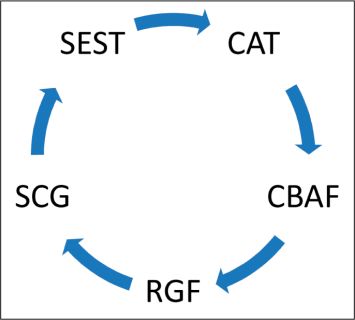
Social-Ecological Systems Theory (SEST)
The theoretical underpinning of this paradigm is rooted on the SEST. The theory presented by Berkes et al. (2000) offers a comprehensive understanding of the interconnectedness between social and ecological systems. The selection was made based on its strong ability to clarify the intricate interconnections that define the socio-environmental relationship in the Kullu region. The literature review shed light on the interdependent connection between the ecological dynamics of Kullu and its social structures, highlighting the need for a comprehensive framework that can analyze and tackle these intricate relationships.
Communicative Action Theory (CAT)
Habermas (1984) established the CAT, which has been incorporated into the framework to leverage the researcher’s proficiency in environmental communication. The selection of this theory was based on its strong focus on rational communication and its ability to promote mutual understanding and collaborative action within societal frameworks. Previous studies on the governance systems of Kullu have identified a requirement for a theoretical framework capable of critically examining and improving the communicative mechanisms operating within these systems.
Community-Based Adaptation Framework (CBAF)
The conscious decision to include the CBAF, as outlined by Reid et al. (2009), within the theoretical framework was motivated by the recognition that local knowledge and experiences play a crucial role in creating adaptive responses to climate threats. The inclusion of this component within the framework demonstrates a dedication to amplifying the perspectives and knowledge of local stakeholders, as highlighted in the first examination of relevant scholarly works. This recognition is essential for the development of enduring and efficient adaptation approaches in the region of Kullu.
Risk Governance Framework (RGF)
The multidimensional theoretical construct is completed by the RGF, as outlined by Renn (2008). The adaptation of this paradigm was prompted by the identified necessity for a comprehensive approach to risk management that integrates scientific inquiry and active stakeholder interaction. The previous study emphasized the significance of a governance system that is both scientifically rigorous and socially inclusive, while also being sensitive to the specific local context of Kullu.
The integration of various ideas into a coherent framework demonstrates the researcher’s intention to develop a scholarly narrative that is academically rigorous and closely aligned with the actual experiences of the Kullu region. This study employs a theoretical framework to explore the intricate nature of climate risk, employing a systematic and inquiring methodology. The objective is to provide a valuable contribution to the enhancement of resilience in Kullu, particularly in response to climate-related difficulties. The framework has been developed through a comprehensive examination of existing scholarly works and the integration of several theoretical viewpoints, specifically selected for their pertinence and suitability in addressing the diverse components of climate risk within the region.
Methodology
Research Design
The research design employed in this study is exploratory in nature, with a focus on analyzing secondary data to examine the complexities associated with climate risk in the region of Kullu, located in Himachal Pradesh. The approach of this study is crucial in developing a comprehensive narrative that is supported by empirical evidence. It enables a thorough examination of existing literature and datasets that provide insights into the climate risk profile of the region.
Data Collection
The maintenance of methodological rigor in data gathering is achieved by employing a secondary database consisting of peer-reviewed scientific articles, government reports, and records from nongovernmental organizations. The database incorporates prominent databases like Web of Science, Scopus, and government archival records to guarantee the inclusion of highly credible and relevant data pertaining to the Kullu region. The reports produced by the IPCC are particularly noteworthy due to their comprehensive data and authoritative analysis of climate-related hazards and mitigation options. In a similar vein, the documentation provided by nongovernmental organizations presents a wealth of empirical data and invaluable perspectives on how communities are addressing climate concerns. This information is crucial for comprehending the techniques employed at the local level to adapt to these challenges. Figure 2 provides a clear, structured visualization of our research methodology, encapsulating the various stages of data collection, analysis, and interpretation which are pivotal to the comprehensiveness of this research.
Figure 2. The Structure of Research Design.
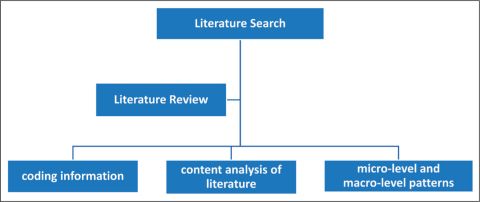
Data Analysis
The secondary data acquired from these databases underwent a rigorous analytical procedure, starting with content analysis to identify patterns, themes, and significant observations. This procedural stage entails the methodical process of assigning codes and organizing data in a manner that is consistent with the goals and objectives of the research. After conducting a content analysis, we will utilize a comparative method to contrast the gathered data. This approach will aid in identifying similarities, differences, and patterns among various sources and time periods. The importance of doing such a comparison lies in its ability to provide a contextual framework for understanding the Kullu region in relation to wider discussions on climate risk.
The purpose of these methodological procedures is to incorporate micro-level specifics with macro-level patterns, guaranteeing that the research results are strong, extensive, and representative of both the distinct circumstances of Kullu and the fundamental principles of climate risk governance. The study seeks to provide a significant contribution to the scientific knowledge of climate risk assessment, management, and governance in the Kullu region by employing a methodical approach.
Findings and Analysis
Historical Climate Trends in Kullu
Temperature Variations
The extensive literature analysis conducted by Sharma and Tomar (2017) highlights a concerning increase in seasonal temperatures in the Kullu region over the past few decades. The observed phenomenon, distinguished by a gradual yet consistent upward trajectory, possesses the capacity to substantially modify the regional climate norm. The significant ramifications of the increasing temperatures are far-reaching, affecting not only the biodiversity and ecosystems of the region but also the socioeconomic structure of Kullu. These implications may manifest in altered agricultural cycles, heightened energy requirements, and increased health hazards.
Precipitation Patterns
The report released by the State Government of Himachal Pradesh in 2012 provides insights into the changing precipitation patterns, characterized by prolonged periods of limited rainfall and a decrease in snowfall. The observed changes in precipitation patterns serve as an indication of a more extensive shift in the hydrological systems within the region. The potential consequences of these alterations are significant, with the ability to disrupt water security, soil moisture levels, and subsequently causing a series of repercussions on agriculture, hydroelectric power generation, and the ecological systems that depend on consistent seasonal rainfall.
Climatic Risks and Vulnerabilities
The study conducted by Bhardwaj et al. (2011) examines various case studies that provide light on the escalating vulnerability to hydrological changes in the Kullu region. These case studies specifically emphasize a rise in the occurrence and severity of flash floods. These occurrences pose a risk not just to human populations and their means of subsistence but also to the preservation of natural environments and the biodiversity they sustain. The hydrological vulnerabilities discussed in this context give rise to the need for a reassessment of methods pertaining to land-use planning, infrastructure development, and disaster preparedness.
Graph 1. Graph of Climatic Risks and Vulnerabilities (1980–2020).
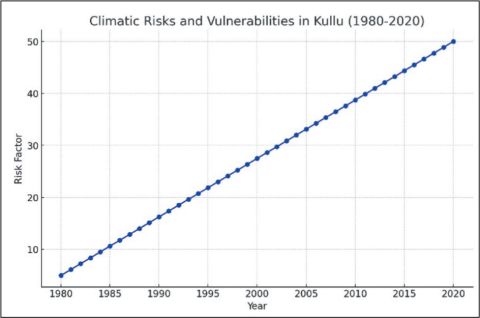
Graph 1 shows an increase in climatic risks such as floods and landslides over time. The risk factor, represented on the y-axis, increases from 1980 to 2020, indicating heightened vulnerability.
Table 1 illustrates the average annual temperature and total annual precipitation in Kullu from 1980 to 2020. The data indicate fluctuations in both temperature and precipitation over the years.
Agricultural Impacts
Sharma and Tomar (2017) conducted an examination of the fluctuating climatic circumstances, which have resulted in a significant alteration in agricultural practices in the region of Kullu. In response to the increasing unpredictability of traditional crop cycles, farmers are embracing a more diverse approach to their agriculture practices. The implementation of strategic diversification is perceived as an adaptive measure in response to the uncertain nature of climatic variability. Its primary objective is to reduce the potential risks associated with food security and ensure the sustainability of agricultural livelihoods.
Existing Climate Risk Management Strategies
Chart 1. Distribution of Various Strategies.
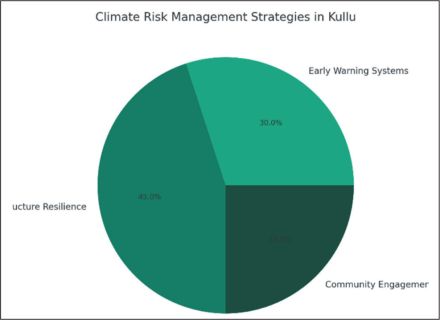
The pie chart depicts the distribution of various strategies used in Kullu, including early warning systems, infrastructure resilience, and community engagement.
Early Warning Systems
The proactive use of early warning systems by regional authorities, as described in multiple publications, signifies their efforts to limit the risks posed by climatic adversities. According to the State Government of Himachal Pradesh (2012), it is recognized that although these systems represent a positive development, they are still in their early stages and necessitate substantial progress in terms of technology, dissemination, and public awareness in order to attain their maximum effectiveness.
Infrastructure Resilience
A collaborative endeavor has been undertaken, as documented in scientific literature and nongovernmental organization publications, to promote the development of climate-resilient infrastructure in the region of Kullu. Notwithstanding the advancements made thus far, there exists a widely acknowledged imperative to enhance inclusivity and extend services, notably to geographically isolated regions. The implementation of such measures would contribute to a more balanced allocation of resources and the establishment of safety protocols, both of which are crucial for the long-term resilience of communities in the face of climate change (Bhardwaj et al., 2011).
Governance and Policy Dynamics
Table 2 lists key policies and plans along with their impact assessments. The policies include the Himachal Pradesh State Climate Plan, Kullu District Adaptation Program, and the National Climate Policy.
Policy Landscape
The current policy framework in Kullu is influenced by strategic initiatives, such as the Himachal Pradesh State Climate Change Strategy and Action Plan. This proposal represents a significant advancement in the establishment of a well-organized framework for climate risk governance. This strategy establishes a fundamental framework for a synchronized approach to addressing climate hazards by incorporating scientific knowledge and policy measures. Nevertheless, it is imperative that these strategies remain adaptable and consistently revised in order to incorporate the most recent scientific discoveries and real-world circumstances (State Government of Himachal Pradesh, 2012).
Community Engagement
There has been a notable and positive trend observed in relation to heightened community involvement in governance procedures. The transition toward a decentralized and participatory governance framework facilitates inclusivity and leverages local expertise in policy formulation. The importance of such participation lies in its ability to guarantee the cultural relevance, social acceptability, and successful implementation of climate adaptation methods (Sharma & Tomar, 2017).
Community-Centered Approaches
Graph 2. Community-Centered Approaches (1980–2020).
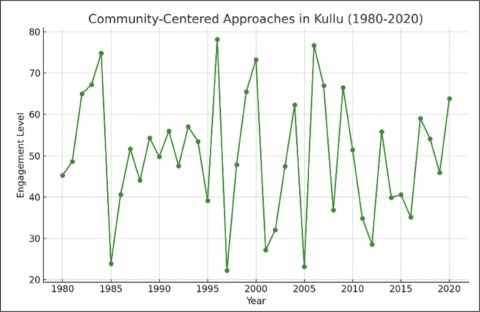
Graph 2 illustrates the level of community engagement in Kullu over time, highlighting an increasing trend in integrating community knowledge and participation in climate governance.
Traditional Knowledge
Bhardwaj et al. (2011) highlight the significant contribution of indigenous populations in Kullu through their research of community-based narratives, shedding light on the extensive traditional knowledge held by these communities. The knowledge that has been transmitted across generations possesses a wealth of ideas pertaining to sustainable living and adaptation strategies that have been carefully tailored to suit the specific environmental conditions of the region. The recognition and use of this knowledge into formal adaption strategies has the potential to offer resilient and contextually suitable solutions to the evolving climate problems.
Socioeconomic Factors
The community’s ability to adapt to climate change is hindered by socioeconomic restrictions, including restricted access to education, low levels of income, and inadequate health care facilities, despite the presence of a store of traditional wisdom. The research conducted by Sharma and Tomar (2017) emphasizes the pressing need to improve.
Chart 2. Socioeconomic Factors.
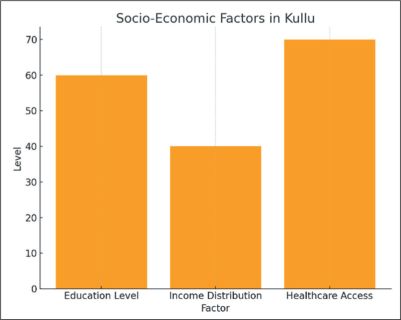
The bar chart represents various socioeconomic factors, like education level, income distribution, and health care access, showing their levels in the Kullu region.
Discussion
Addressing Historical Climate Trends
The Evolution of Climate Change as an Ongoing Phenomenon
According to Sharma and Tomar (2017), a careful examination of temperature and precipitation trends provides more evidence that the effects of climate change are becoming increasingly apparent in Kullu’s natural setting. The researcher recommends that an ongoing longitudinal study be carried out in order to assist in the process of designing adaptive methods that are both dynamic and responsive to the shifting climate patterns.
Rethinking Water Resource Management
The changing patterns of precipitation make it abundantly clear that the management of the region’s water resources need a fundamental reappraisal. According to statistics gathered from real-world experience (State Government of Himachal Pradesh, 2012), the potential solution to the looming water issue may lie in the collection of rainfall and the development of environmentally friendly irrigation technologies.
Strategizing Against Climatic Risks and Vulnerabilities
Integrating Hydrological Risk Management
Alterations to hydrology pose significant dangers to the local ecosystems as well as the communities that depend on them. Utilizing the nuanced insights obtained from the case studies and empirical data investigated (Bhardwaj et al., 2011), it would be reasonable to integrate hydrological risk management within the larger framework for climate governance. This would be a pragmatic move.
Strengthening the Resilience of Agricultural Systems
According to Sharma and Tomar (2017), agricultural transitions necessitate the construction of resilience through the possible introduction of climate-resilient crop varieties and the promotion of community training programs to manage agricultural practices in a climate that is changing.
Evaluating the Current Climate Risk Management Strategies
Improving the Availability of Early Warning Systems
Even if early warning systems have been put into place, there is still room for significant improvement, possibly through the utilization of technical breakthroughs that will improve accuracy and reach (State Government of Himachal Pradesh, 2012).
Bridging Infrastructure Gaps
According to the findings of the study (Bhardwaj et al., 2011), there is an urgent need to close infrastructure gaps by promoting investments in climate-resilient infrastructure, guaranteeing inclusivity and equity in the distribution of resources and safety systems, and ensuring that all people have equal access to these things.
Governing for the Future
Policy Dynamics
Policy frameworks, such as the Himachal Pradesh State Climate Change Strategy and Action Plan, offer the groundwork for climate change response in the form of a foundational blueprint (State Government of Himachal Pradesh, 2012). The researcher advises that these frameworks should be evaluated and modified frequently to accommodate developing climate realities and scientific understandings. This should be done on a regular basis.
Facilitating Community Engagement in Governance
According to Sharma and Tomar (2017), community engagement in governance not only promotes inclusivity but also makes use of local knowledge in policy articulations. This presents a paradigm of decentralized, participatory government that might be further cultivated and institutionalized.
Leveraging Community-Centered Approaches
Recognizing and Integrating Traditional Knowledge
In the process of developing strategies for sustainable adaptation, traditional knowledge emerges as an essential resource. According to Bhardwaj et al. (2011), the researcher supports the idea that there should be a determined effort made to document and incorporate this knowledge into mainstream policy and planning.
Structural Improvements to the Socioeconomic System
Last but not least, according to Sharma and Tomar (2017), it is essential to improve the socioeconomic fabric of the community through educational and economic interventions in order to establish a community that is robust to the changing climate. This will allow the community to fully harness its adaptive capacities.
Theoretical and Practical Implications
Theoretical Implications
Enrichment of Social-Ecological Systems Theory
The observed increases in temperature and alterations in precipitation patterns provide empirical support that enhances the SEST. The research findings provide empirical evidence that aligns with the theoretical proposition that societal and ecological systems are intricately linked, such that alterations in one system eventually exert an influence on the other. The theoretical implications encompass a refined comprehension of the ways in which climate factors impact these interdependencies, particularly within mountainous ecosystems.
Advancements in Communicative Action Theory
The study’s findings about community engagement and the incorporation of traditional knowledge into climate risk governance make significant contributions to the field of CAT. The aforementioned statement highlights the significance of employing dialogic methods as a means to attain mutual comprehension and consensus in climate adaptation endeavors. Consequently, this contributes to the advancement of theoretical deliberations surrounding participatory governance.
Evolution of Risk Governance Frameworks
The findings concerning early warning systems and infrastructure resilience underscore the need for a multifaceted approach to risk governance that goes beyond traditional paradigms. The study posits that it is imperative for RGFs to possess a dynamic nature, encompassing the integration of technological advancements and the expansion of infrastructure.
Community-Based Adaptation (CBA) Framework
The study emphasizes the significant influence of socioeconomic factors on the effectiveness of community-based adaptation methodologies. Theoretical implications indicate that in order to enhance community resilience in an effective manner, the CBAF should incorporate socioeconomic growth.
Practical Implications
The findings of this study indicate the need for regular review and updating of policies, such as the Himachal Pradesh State Climate Change Strategy and Action Plan. This is necessary to incorporate the most recent empirical evidence and to ensure their adaptability to changing climate conditions.
The necessity for enhanced disaster planning and management techniques arises from the heightened occurrence of flash floods resulting from hydrological alterations. This entails the improvement of early warning systems and the implementation of public education initiatives in order to mitigate the susceptibility of local communities.
The alteration of agricultural practices requires the implementation of effective measures, such as the creation of crop varieties that can withstand climate changes and the provision of educational programs for farmers to adopt adaptive agricultural techniques. These interventions are crucial in safeguarding food security amid shifting climatic conditions.
The research advocates for a greater allocation of funds toward the development of infrastructure that is robust to climate change impacts. This should be done with a particular emphasis on promoting inclusion and ensuring equitable distribution of resources. Pragmatic strategies encompass bolstering the durability of current infrastructure and ensuring that forthcoming developments are conceived with careful regard for the implications of climate change.
The incorporation of traditional knowledge is advocated in this study, with a focus on documenting and integrating it into mainstream policies related to adaptation and risk management. The acquisition and application of this knowledge necessitate a methodical methodology for its capture and the establishment of mechanisms to effectively convert it into tangible and applicable solutions.
Socioeconomic enhancement is a crucial aspect of bolstering community adaptive capacity, as it involves tackling key concerns such as education, income, and access to health care. There is a pressing need for the implementation of pragmatic interventions aimed at enhancing the socioeconomic determinants. Such interventions would subsequently bolster the resilience of communities in the face of climate change.
Conclusion
Upon analyzing the complex array of climate risk scenarios presented in the research findings and accompanying debate, it becomes evident that Kullu, Himachal Pradesh, is currently facing a pivotal moment in its climatic trajectory. The researcher has conducted a thorough analysis based on empirical evidence and scholarly discussions, emphasizing the pressing need to confront the growing climate disaster in the region.
Climate Dynamics: A Historical and Contemporary Perspective
Based on the data, it is apparent that Kullu is experiencing a significant transformation in its climatic patterns, marked by rising temperatures and changing precipitation patterns. The evolving dynamics of the situation require a comprehensive reassessment and adjustment of current policies in order to maintain the fragile ecological equilibrium of the area (Sharma & Tomar, 2017).
Vulnerabilities and Risks in the Context of Security
The magnitude of vulnerabilities and dangers arising from hydrological alterations and agricultural consequences is substantial. The authors of the study (Bhardwaj et al., 2011) presented a well-reasoned debate advocating for the implementation of comprehensive risk management techniques that are both resilient and adaptable. These strategies aim to protect communities and enhance agricultural resilience in response to the persistent changes in climate.
The Development of Climate Risk Management Strategies
As elucidated in the discourse, it is crucial to augment the prevailing climate risk management methodologies, incorporating advanced early warning systems and infrastructure resilience. According to the researcher, it is crucial for these strategies to be based on scientific advancements and promote inclusivity, in order to prevent the remote areas from being marginalized in the climate action plan (State Government of Himachal Pradesh, 2012).
The Role of Governance and Community-Centric Approaches
From a governance standpoint, it is evident that the policy environment, albeit strong, needs to adapt dynamically to effectively integrate the evolving climate realities with great attention to detail. According to Sharma and Tomar (2017), the researcher supports the implementation of a governance framework that is adaptable and receptive, fostering active involvement from stakeholders and enabling more extensive community interactions. This approach aims to leverage the valuable resources of local knowledge and perspectives.
Prospects for Future Development
The researcher anticipates a future trajectory that is rooted in sustainable and community-centric methodologies. The utilization of ancient knowledge systems and the strengthening of the socioeconomic fabric are identified as crucial elements in this proposed trajectory. The researcher suggests that adopting an integrative approach that combines scientific expertise with traditional knowledge may lead to the development of a resilient and sustainable adaptation strategy in the region of Kullu.
In summary, this study provides a comprehensive analysis of the climate risk scenario in Kullu, Himachal Pradesh. Based on a thorough examination of secondary data, this study emphasizes the necessity of establishing a trajectory marked by accountable governance, advancements in scientific research, and active engagement from the community. The researcher anticipates that by thoroughly examining the various dimensions highlighted in this study, there is potential for Kullu to develop resilience and adaptability in the face of climate challenges. This could lead to a future where Kullu serves as a positive example of sustainable and harmonious coexistence with the natural environment.
Declaration of Conflicting Interests
The authors declared no potential conflicts of interest with respect to the research, authorship, and/or publication of this article.
Funding
The authors received no financial support for the research, authorship, and/or publication of this article.
ORCID iDs
K. M. Baharul Islam  https://orcid.org/0000-0002-0858-7198
https://orcid.org/0000-0002-0858-7198
Archan Mitra  https://orcid.org/0000-0002-1419-3558
https://orcid.org/0000-0002-1419-3558
Asif Khan  https://orcid.org/0000-0003-4543-0672
https://orcid.org/0000-0003-4543-0672
Sayani Das  https://orcid.org/0000-0003-0076-7466
https://orcid.org/0000-0003-0076-7466
Allen, S., Ballesteros-Canovas, J., & Bahinipati, C. (2020). Climate risk assessment: A pilot study in Kullu, Himachal Pradesh [Technical report]. https://www.researchgate.net/publication/357656871_CLIMATE_RISK_ASSESSMENT_A_Pilot_study_in_Kullu_ Himachal_Pradesh
Berkes, F., Folke, C., & Colding, J. (2000). Linking social and ecological systems: Management practices and social mechanisms for building resilience. Cambridge University Press.
Bhardwaj, P., Upadhyay, S., & Jindal, T. (2011). Climate change and its impacts on the ecosystems of Himachal Pradesh: Case study on the cold desert ecosystem of Lahaul-Spiti and Kullu District. Journal of Biodiversity and Ecological Sciences, 1(4), 293–312.
Habermas, J. (1984). The theory of communicative action. Beacon Press.
Huggel, C., Allen, S., Wymann Von Dach, S., Dimri, A. P., Mal, S., Linbauer, A., Salzmann, N., & Bolch, T. (2020). An integrative and joint approach to climate impacts, hydrological risks and adaptation in the Indian Himalayan Region. In Himalayan weather and climate and their impact on the environment (pp. 553–573). Springer.
IHCAP. (2016). Climate vulnerability, hazards and risk: An integrated pilot study in Kullu District, Himachal Pradesh [Synthesis Report]. Http://Admin.Indiaenvironmentportal.Org.In/Reports-Documents/Climate-Vulnerability-Hazards-And-Risk-Integrated-Pilot-Study-Kullu-District#:~:Text=The%20report%20introduces%20an%20integrated,Ihr
IPCC. (2014). Climate Change 2014: Synthesis report. Contribution of working groups I, II, and III to the fifth assessment report of the intergovernmental panel on climate change. IPCC. https://www.ipcc.ch/report/ar5/syr/
Kumar, L., Sharma, V. R., & Sanu, S. K. (2022). Examining Kullu District’s past disastrous incidents and its impact on livelihood: With special reference to earthquake. Education and Society, 46(4), 36–42.
Moser, S. C. (2010). Communicating climate change: History, challenges, process and future directions. Wiley Interdisciplinary Reviews: Climate Change, 1(1), 31–53.
Reid, H., Alam, M., Berger, R., Cannon, T., Huq, S., & Milligan, A. (2009). Community-based adaptation to climate change: An overview. In H. Ried (Ed.), Community-based adaptation to climate change (pp. 11–33). IIED.
Renn, O. (2008). Risk governance: Coping with uncertainty in a complex world. Earthscan.
Sharma, E., & Tomar, S. (2017). Climate change impacts and adaptation in the Indian Himalayas: A critical review. Climate Development, 9(1), 99–113.
Singh, R. B., & Singh, S. (2017). Climate change and its impact on the ecosystems of the Himalayan Region. In Climate change and biodiversity (pp. 45–64). Springer.
State Government of Himachal Pradesh. (2012). Himachal Pradesh state climate change strategy and action plan. Environment, Science, and Technology Department.